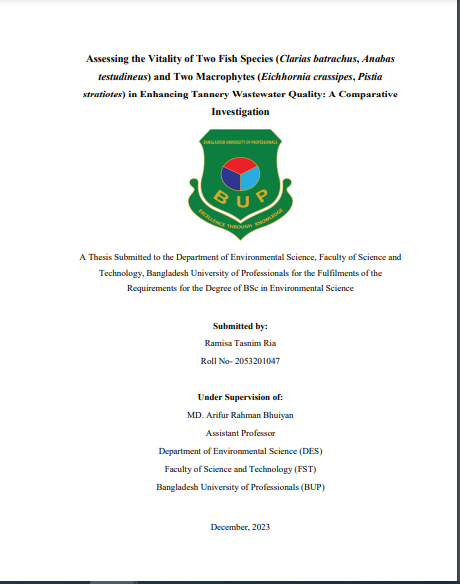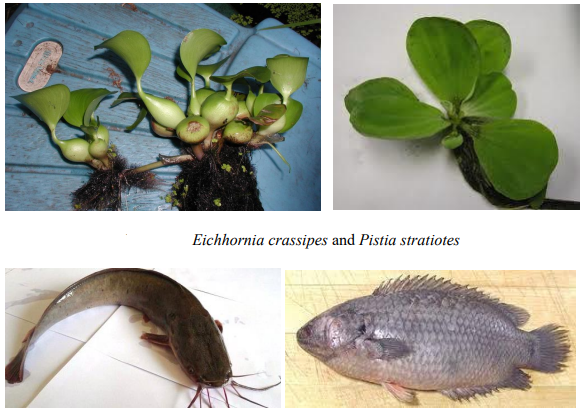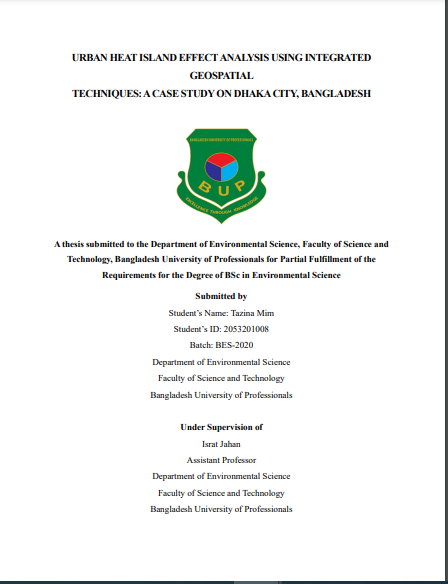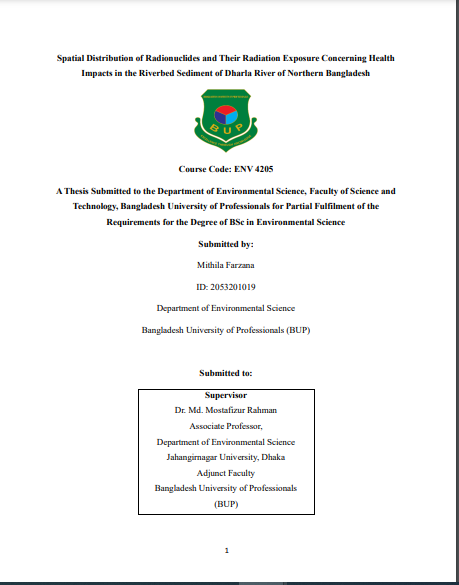
Assessing the Vitality of Two Fish Species, A Comparative Investigation. One Clarias batrachus, Anabas testudineus and Two Macrophytes, Eichhornia crassipes, Pistia stratiotes in Enhancing Tannery Wastewater Quality. A Comparative Investigation.
Freshwater in Bangladesh is losing its usability over time for a number of reasons, such as shifting agricultural practices, declining fisheries supplies, or changes in land usage.
It is common knowledge that access to sufficient water is essential for survival. Lakes and rivers are put in risk when between 100% and 80% of untreated wastewater is released into the environment.
Tannery effluent is extremely hazardous due to high organic loadings, solids, and metals, particularly chromium (Cr), a well‐known pollutant to aquatic environments, and ultimately, human beings. The dark color and low oxygen content of tannery effluents indicates the strength of pollution, which ultimately affects the survival of aquatic organisms.
Almost all types of fish are quite sensitive to polluted environment, and pollutants found in tannery effluent cause significant damage to their physiological and biochemical processes, such as endocrine disruption.
| Report Title : | Assessing the Vitality of Two Fish Species. |
| University Name : | Bangladesh University of Professionals |
| Submitted To : | MD. Arifur Rahman Bhuiyan |
| Submitted By : | Ramisa Tasnim Ria |
| Total Page : | 128 |
Background of the Study:
Huge physiological, histological, hematological, behavioral, genetic, biochemical, and immunological alterations in aquatic organisms have been reported due to Cr exposure. Remediation of toxic industrial effluents is very important for the protection of the environment.
The quality of these effluents is most commonly monitored by analyzing major pollution parameters such as pH, electrical conductivity (EC), dissolved oxygen (DO), biochemical oxygen demand (BOD), chemical oxygen demand (COD), total organic carbon (TOC), total dissolved solids (TDS), total suspended solids (TSS), and metals.
Tannery wastewater may contaminate water bodies in Bangladesh in a number of ways. Discharge of untreated or partially treated wastewater into the rivers or canals is one method. This can take place if the treatment facilities are insufficient or poorly maintained. It might affect the environment and the general public’s health.
Untreated wastewater may include a range of dangerous elements, such as bacteria, viruses, minerals, and chemicals, that might be damaging to both human health and the environment.

Contamination of surface and groundwater sources, such as rivers, lakes etc might be a consequence of untreated tannery wastewater. These water bodies can get contaminated when wastewater is dumped into the environment, making them unfit for human use and posing harm to aquatic life.
Problem Statement:
Tannery Industries use various chemicals for leather production and wastewater released by the tannery industries can be a source of toxic chemicals. Tannery wastewater is a major environmental concern due to its high content of toxic pollutants such as heavy metals, organic compounds, and salts.
The recently constructed Savar tannery industrial estate may lead to soil, water, and plants contamination around that area. The discharge of untreated tannery wastewater into water bodies can lead to severe environmental and public health issues. Many studies have focused on bioremediation and phytoremediation strategies for treating tannery wastewater.
But it is not well observed that which species among Eichhornia crassipes, Pistia stratiotes, Clarias batrachus, Anabas testudineus can improve the quality of tannery waste water more efficiently. Moreover, there is limited findings about at which concentration, the species worked their best.
Research Gap:
There are few comparative studies on the efficiency of Eichhornia crassipes, Pistia stratiotes and fish species Clarias batrachus, Anabas testudineus in the remediation of tannery wastewater. Most previous studies have focused on the use of a single fish species or different fish species without comparing their efficiency. Moreover, there is limited findings about at which concentration, the species worked their best.
Therefore, this study aims to address this research gap by comparing the efficiency of Eichhornia crassipes, Pistia stratiotes and fish species Clarias batrachus, Anabas testudineus in improving the quality of tannery wastewater and also at which concentration, the species worked best.
Research Questions:
- Among Eichhornia crassipes, Pistia stratiotes and fish species Clarias batrachus, Anabas testudineus which species worked most efficiently in improving tannery wastewater quality?
- At which wastewater concentration did the species perform best?
Research Objectives:
- To determine the ideal wastewater concentration for Eichhornia crassipes, Pistia stratiotes and fish species Clarias batrachus, Anabas testudineus in improving tannery wastewater quality.
- To find out the best species among all in improving tannery wastewater quality.
Outline of the Thesis :
In Chapter 01:
Background of the Study, Problem Statement, Research Gap, Research Questions: Research Objectives, Scope of the Study Limitations of the Study, Organization of the Paper.
In Chapter 02: Literature Review
The Negative Impact of Tannery Wastewater on the Environment, Phytoremediation Approach in Improving the Water Quality, Water hyacinth (Eichhornia crassipes), as an Effective Phytoremediation Tool, Water lettuce (Pistia stratiotes), as an Effective Phytoremediation Tool, Bioremediation Approach in Improving the Water Quality Climbing perch (Anabas testudineus), as an Effective Bioremediation Tool, Magur fish (Clarias batrachus), as an Effective Bioremediation Tool.
In Chapter 03: Materials and Method
Conceptual Framework, Research Flow Diagram, Collection of Wastewater Samples, Collection of Species: Macrophytes and Fishes, Data Sources, Experimental Design, Preparation of Treatment, Batch Culture for Phytoremediation and, Bioremediation, Experimental Procedure, Water Quality Analysis, Instruments of Water Quality Checking Parameters, Determination of Chemical Parameters, pH, Electrical Conductivity (EC), Total Dissolved Solids (TDS), Biological Oxygen Demand (BOD5), Chemical Oxygen Demand (COD), Total Suspended Solid (TSS), Salinity, Determination of Pollutant Removal Efficiency, Statistical Analysis.
In Chapter 04: Results and Discussion:
Background Analysis of Tannery Wastewater Sample, Determination of Chemical Parameters After Treatment, Changes of pH, Changes of DO, Changes of BOD5, Changes of COD, Changes of TDS, Changes of TSS, Changes of Turbidity, Changes of EC, Changes of Salinity, Discussion, Observation on pH, Observation on DO, Observation on BOD5, Observation on COD, Observation on TDS, Observation on TSS, Observation on Turbidity, Observation on EC, Observation on Salinity, One- Way Analysis of Variance (ANOVA) Test Results, Species Order Based on Efficiency at 25% Wastewater Concentration
In Chapter 05: Conclusion and Recommendation:
Conclusion:
Long term exposure to the contaminated water can be harmful for fish and humans upon frequent consumption. Further research is required to observe the impact of such exposure to organisms. After treatment the species can be used to make biogas which can be helpful in meeting the fuel demand. Strict monitoring is necessary to ensure that this strategy yields the most possible advantage. Fish and macrophytes need to be closely observed. Because of this, industry needs hire trained workers.







